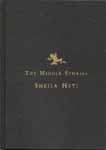 |
The Middle Stories
by Sheila Heti
Anansi Press, 2001
Reviewed by Michael Bryson
At the beginning of an article on Friedrich Nietzsche,
University of Toronto philosophy professor Mark Kingwell quotes Albert
Camus on Kafka: "The whole art of Kafka consists in forcing the
reader to reread." (To see the Kingwell article, visit
the Britannica.com web site.)
Kingwell expands on Camus' point:
The hanging storylines, the vague not-quite-endings,
the dreamy unfulfilled narrative logic - all these features of Kafka's
style turn the reader back to the story and back to the experience of
reading itself.
The same can be said about Sheila Heti's delightfully
weird (if you're the right kind of reader) debut, The Middle Stories.
If you're the wrong kind of reader - that is, not the
kind of reader who enjoys being turned back on "the experience of
reading itself" - then The Middle Stories are sure to
frustrate you. They are at once familiar and unfamiliar; they are short,
structured like fairytales, but they do not comfort. They do not provide
pat, moral endings. They often seem to deliberately confuse. They tease,
they poke, they make you want to throw the book across the room. But
then you return to them, and you think: how curious, how interesting,
how nervy.
Kakfa's stories often turned on questions of law. Or
if not "of law", then "about law" - various kinds of
law, or duty. Gregor Sampson is turned into a bug: how does this change
his relationship with his family? Kafka's titles often turn on images of
prosecution or confinement: The Trial, "The Penal
Colony". Kafka's characters struggle with the weight of imposed
responsibilities, or imposed - often mysterious - codes of conduct.
Kafka's readers are forced to confront the process of making meaning -
whose meaning? and how does that meaning affect others?
Sheila Heti has been described as "a
wunderkind" (National Post). And The Middle Stories created
a buzz (at least in the nepotistic Toronto literary/publishing scene)
well before it was released in the spring of 2001. Most reviews I've
seen, however, have been guarded in their praise - often finding fault
with the collection's tone (monotonous, cynical) - or praising it
with the cop-out "this book marks Heti as an author to watch."
Indeed, she is an author to watch - but what are we to
make of the work at hand? Personally, I didn't like it as much as I
thought I was going to like it. On the other hand, I think the story
"The Poet and Novelist as Roommates" ought to shoot straight
into the Oxford's anthology of Canadian literature.
The poet went softly to the novelist's bedroom, while
the novelist lay asleep, sleep coming heavy like a stink through his
nose. The poet stood in the doorway, watching, pressing down on the
doorframe.
He loved his roommate. But not like that. It was four
in the morning and why had he woken? Sleep was a burden for a man like
him. And yet here was a man who slept through the night.
"He must be in a state of guilt," the poet
thought, before turning and going to bed. Padding through the hall he
asked himself quietly, "What am I doing in this city? Even looking
at the clouds I feel I have lost my imagination."
Reading Heti, you are likely to think: where did this
come from? Kafka is a strong precursor, but so is a crowd of Toronto
writers that tend to have Ken
Sparling in common. Namely, Hal
Niedzviecki, Derek McCormack, Geoffrey Brown,
Natalee Caple, and Alexandra Leggat, to name a few. Sparling,
in fact, edited an earlier version of Heti's manuscript - for Gutter
Press, McCormack's and Brown's publisher, and one-time owner of the late
The Quarterly, the New York City-based organ of American
editorial rogue Gordon Lish. To complete the circle: Lish edited Ken
Sparling's book for Knopf - but more famously, he edited Raymond
Carver's breakthrough, What We Talk About When We Talk About Love,
bending Carver away from his natural Chekhovian impulses and turning him
into a kind of middle-American Kafka.
Hmm. Placed in this company, Heti ceases to seem so
original - and instead finds a home in a community of writers that spans
both the continents and the decades. What stands out most about her, is
the ease with which she has been adopted by the chattering classes
(hello Marni Jackson!). In summer 2000, her work appeared as part of the
Toronto Life annual fiction issue, introduced in fawning
editorial. She has, in short, become a name to drop to show that you're in
the know. (You're also expected to know that six of the stories in The
Middle Stories first appeared in Dave Egger's solipsistic McSweeney's,
therefore giving them a kind of instant mass media value.)
Heti has become a commodity above and beyond her work.
(So are most people who appear regularly in the mass media, but that's
another story.) This is unfortunate, since what's most interesting about
The Middle Stories - at least to me - is the strong case it makes
for a literary tradition not much heard from in Canada. Heti has nothing
to say about nationalism. She has nothing to say about the immediate
world outside your window. She has nothing to say about psychology - at
least, not the psychological narrative we're so used to hearing: who am
I? how come my life is so shitty? Instead, what we get from Heti is the
challenge to figure out why we bother to read at all. What did we
expect? Something that would make sense?
Michael
Bryson is the editor of The Danforth Review.
|